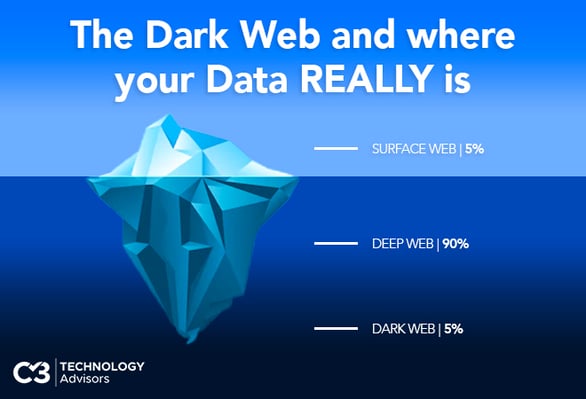Most of us browse the Internet for information. We surf the world wide web for information, entertainment, logistics, and social interaction. Unbeknownst to most users, there are actually different layers to “the web”. You’ve probably heard about the “dark web” and this will quickly explain: what the “dark web” is, where it’s located, and why it matters to you – on a personal and professional level.

Layers to the web
Surface Web
If you’re cruising the internet without logging into a site, you’re enjoying info and content on the surface web. Even with the daily proliferation of websites and an increasing amount of content available to consume, the surface web only represents about 5% of the information available on the “web".
The Deep Web
Underneath the surface web, you’ll find what is called the ‘deep web’. This deep web is primarily made up of password-protected websites and databases – things like scholarly journals, medical records, financial information, and even the emails in your inbox. Believe it or not, the deep web comprises about 90% of the space online.
The Dark Web
If you go looking for it, you can find the deepest elements of the internet – commonly referred to as the dark web. Sites that hide in the dark web comprise the remaining 5% of internet content.
The dark web requires a special internet browser called a TOR browser to gain access. The TOR browser makes all users on the dark web look the same and eliminates digital footprints – meaning users and their activities remain anonymous.
The TOR project was originally developed by the US Navy in the ’90s as a tool for US Navy intelligence agents. To make sure that agent anonymity was protected, TOR browser needed to be available for public use. This allowed Naval intelligence agents to blend in with other users.
While many users surf the dark web with no malicious intent, the anonymous dark web is a perfect place for cybercriminals and wrongdoers to participate in illegal activities . . . illegal sale of drugs, illicit materials, and even your personal information. But why should you care? You’ve never been on the dark web and have no intention to download the TOR browser to access it.
The personal information criminals share and sell on the dark web is comprised of things like birthdates, social security numbers, username/password combos, and more. Imagine what a criminal could do if they got their hands on your highly confidential and intimate data. The implications are not exciting to think about.
For example – a criminal on the dark web can purchase a username/password combo for about $3-$8 on average. The typical adult has 100+ online accounts and reuses the same password across many of them. This means that with that one tiny investment, this criminal might gain access to your personal email, bank accounts, work email, and in some cases, criminals can use this data to hack into back-end systems at the office too.
The Silver Lining
While the dark web may sound intimidating, there are things you can do to protect yourself from some of the activities that go on there. Admittedly, there is little to be done once your private information ends up on the dark web. But there are many tools available that can help protect you from the fallout of your info landing in the wrong hands.
Things like:
- Password Management Solutions
- Multi-Factor Authentication (MFA)
- Dark Web Monitoring Solutions
If you’re curious about how you can better protect yourself and your organization from threats on the dark web, reach out to a C3 Technology Advisor today.


